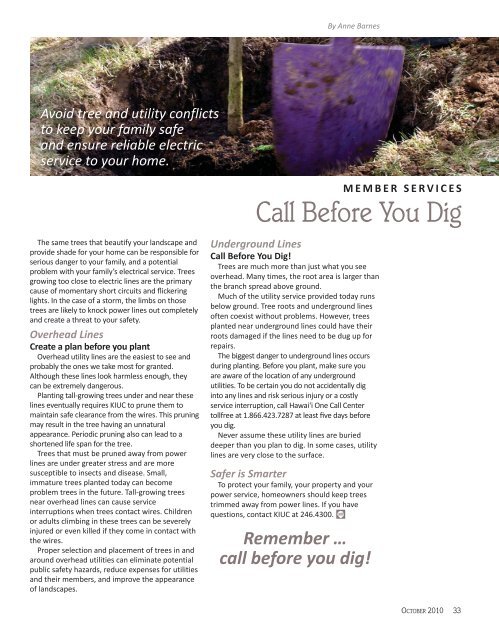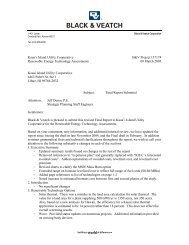Safer is Smarter - Kauai Island Utility Cooperative
Safer is Smarter - Kauai Island Utility Cooperative
Safer is Smarter - Kauai Island Utility Cooperative
Create successful ePaper yourself
Turn your PDF publications into a flip-book with our unique Google optimized e-Paper software.
Avoid tree and utility conflicts<br />
to keep your family safe<br />
and ensure reliable electric<br />
service to your home.<br />
The same trees that beautify your landscape and<br />
provide shade for your home can be responsible for<br />
serious danger to your family, and a potential<br />
problem with your family’s electrical service. Trees<br />
growing too close to electric lines are the primary<br />
cause of momentary short circuits and flickering<br />
lights. In the case of a storm, the limbs on those<br />
trees are likely to knock power lines out completely<br />
and create a threat to your safety.<br />
Overhead Lines<br />
Create a plan before you plant<br />
Overhead utility lines are the easiest to see and<br />
probably the ones we take most for granted.<br />
Although these lines look harmless enough, they<br />
can be extremely dangerous.<br />
Planting tallgrowing trees under and near these<br />
lines eventually requires KIUC to prune them to<br />
maintain safe clearance from the wires. Th<strong>is</strong> pruning<br />
may result in the tree having an unnatural<br />
appearance. Periodic pruning also can lead to a<br />
shortened life span for the tree.<br />
Trees that must be pruned away from power<br />
lines are under greater stress and are more<br />
susceptible to insects and d<strong>is</strong>ease. Small,<br />
immature trees planted today can become<br />
problem trees in the future. Tallgrowing trees<br />
near overhead lines can cause service<br />
interruptions when trees contact wires. Children<br />
or adults climbing in these trees can be severely<br />
injured or even killed if they come in contact with<br />
the wires.<br />
Proper selection and placement of trees in and<br />
around overhead utilities can eliminate potential<br />
public safety hazards, reduce expenses for utilities<br />
and their members, and improve the appearance<br />
of landscapes.<br />
By Anne Barnes<br />
MEMBER SERVICES<br />
Call Before You Dig<br />
Underground Lines<br />
Call Before You Dig!<br />
Trees are much more than just what you see<br />
overhead. Many times, the root area <strong>is</strong> larger than<br />
the branch spread above ground.<br />
Much of the utility service provided today runs<br />
below ground. Tree roots and underground lines<br />
often coex<strong>is</strong>t without problems. However, trees<br />
planted near underground lines could have their<br />
roots damaged if the lines need to be dug up for<br />
repairs.<br />
The biggest danger to underground lines occurs<br />
during planting. Before you plant, make sure you<br />
are aware of the location of any underground<br />
utilities. To be certain you do not accidentally dig<br />
into any lines and r<strong>is</strong>k serious injury or a costly<br />
service interruption, call Hawai‘i One Call Center<br />
tollfree at 1.866.423.7287 at least five days before<br />
you dig.<br />
Never assume these utility lines are buried<br />
deeper than you plan to dig. In some cases, utility<br />
lines are very close to the surface.<br />
<strong>Safer</strong> <strong>is</strong> <strong>Smarter</strong><br />
To protect your family, your property and your<br />
power service, homeowners should keep trees<br />
trimmed away from power lines. If you have<br />
questions, contact KIUC at 246.4300.<br />
Remember …<br />
call before you dig!<br />
OCTOBER 2010 33
















